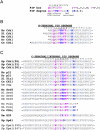Mechanism of CRL4(Cdt2), a PCNA-dependent E3 ubiquitin ligase
- PMID: 21828267
- PMCID: PMC3182024
- DOI: 10.1101/gad.2068611
Mechanism of CRL4(Cdt2), a PCNA-dependent E3 ubiquitin ligase
Abstract
Eukaryotic cell cycle transitions are driven by E3 ubiquitin ligases that catalyze the ubiquitylation and destruction of specific protein targets. For example, the anaphase-promoting complex/cyclosome (APC/C) promotes the exit from mitosis via destruction of securin and mitotic cyclins, whereas CRL1(Skp2) allows entry into S phase by targeting the destruction of the cyclin-dependent kinase (CDK) inhibitor p27. Recently, an E3 ubiquitin ligase called CRL4(Cdt2) has been characterized, which couples proteolysis to DNA synthesis via an unusual mechanism that involves display of substrate degrons on the DNA polymerase processivity factor PCNA. Through its destruction of Cdt1, p21, and Set8, CRL4(Cdt2) has emerged as a master regulator that prevents rereplication in S phase. In addition, it also targets other factors such as E2F and DNA polymerase η. In this review, we discuss our current understanding of the molecular mechanism of substrate recognition by CRL4(Cdt2) and how this E3 ligase helps to maintain genome integrity.
Figures





References
-
- Adimoolam S, Lin CX, Ford JM 2001. The p53-regulated cyclin-dependent kinase inhibitor, p21 (cip1, waf1, sdi1), is not required for global genomic and transcription-coupled nucleotide excision repair of UV-induced DNA photoproducts. J Biol Chem 276: 25813–25822 - PubMed
Publication types
MeSH terms
Substances
Grants and funding
LinkOut - more resources
Full Text Sources
Miscellaneous
